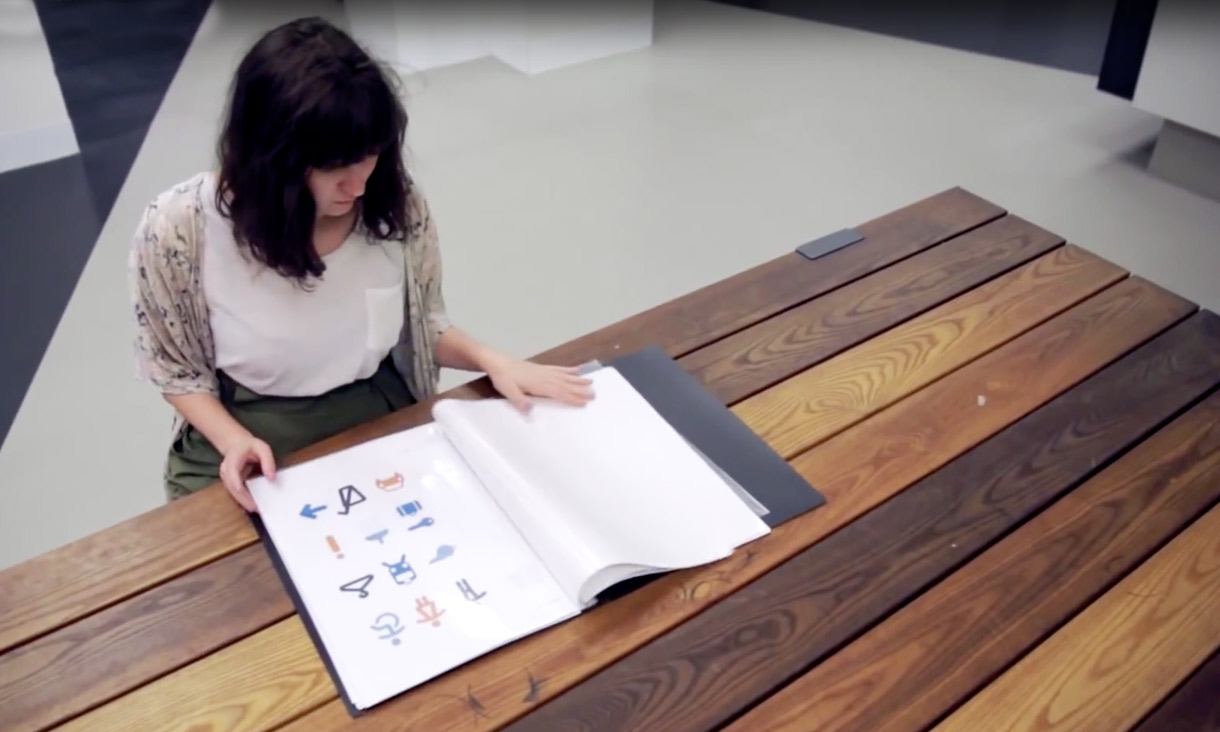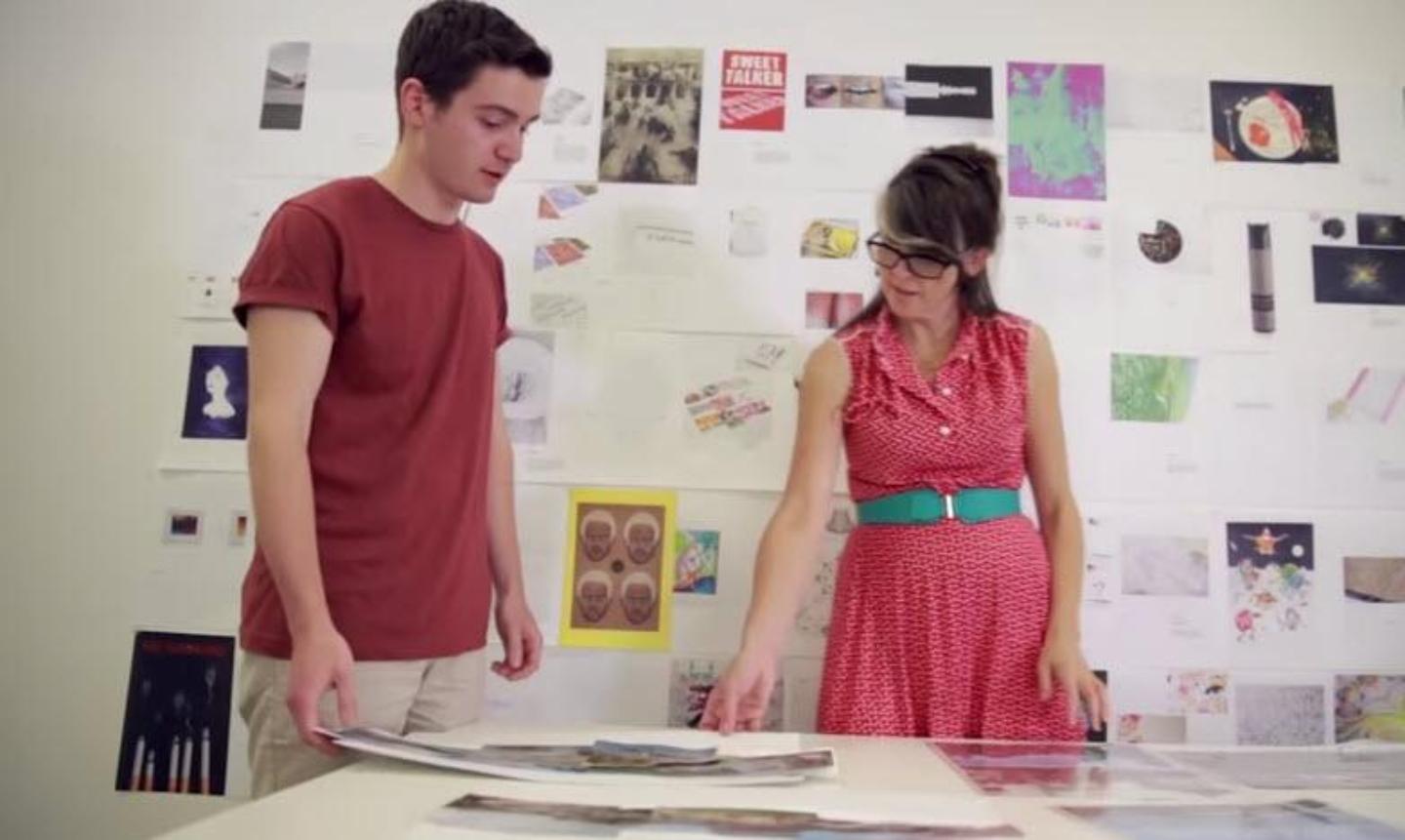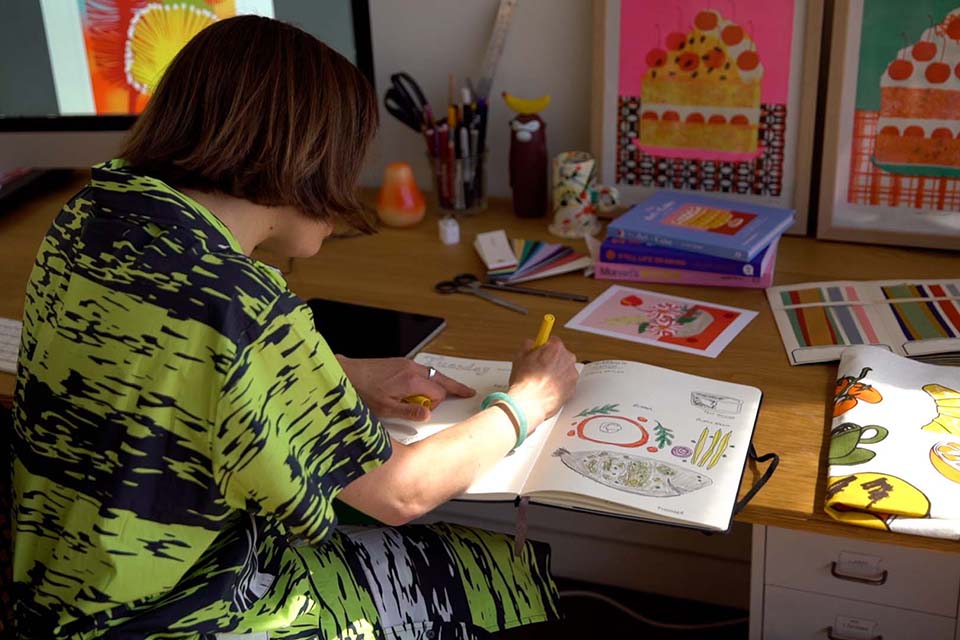Learn from professional design practitioners and start designing in studios that emulate industry best practice from day one.
Not a local student?
Not an international student?
Eaque ipsa quae ab illo inventore veritatis et quasi architecto beatae vitae dicta sunt explicabo.
Eaque ipsa quae ab illo inventore veritatis et quasi architecto beatae vitae dicta sunt explicabo.
Eaque ipsa quae ab illo inventore veritatis et quasi architecto beatae vitae dicta sunt explicabo.

Here's some advice for preparing folios and pre-selection kits to help make the process easier.
Here's some advice for preparing folios and pre-selection kits to help make the process easier.
TEXT ON SCREEN: Applying for art and design courses. Advice for preparing folios and pre-selection kits to help make the process easier.
MUSIC: electronic beat with a building tempo.
VISUAL: Interior Design Student, Maddy Davidson stands in front of an art-covered wall. She talks to an off-screen interviewer.
MADDY DAVIDSON SPEAKS: When I applied, I applied for every course that I could possibly apply for in Melbourne. i checked VTAC, I checked it daily.
VISUAL: A close up of a VTAC Guide dissolves into an interview with another student. Landscape Architecture student, Asa Kremmer talks to camera
ASA KREMMER SPEAKS: With VTAC when you’re applying, the deadlines are so important, so check the requirements.
VISUAL: Photo Imaging student, Billy Carr talks to camera.
BILLY CARR SPEAKS: To prepare for my course, my school didn’t offer photography as an option. I looked to a lot of YouTube videos and anything that would help to boost my skills so that by the time I got to the end of year 12 i was prepared for what I had to do at university.
VISUAL: Photo Imaging student, Eliza Mills talks to camera.
ELIZA MILLS SPEAKS: For my pre-selection kit I checked VTAC to make sure I knew exactly what I needed for my course and the interview for the teachers to get to know me and to enter a certain amount of images of my work.
VISUAL: Lecturer in Design, Jan Henry-Jones stands in a lecture theatre and talks to camera
JAN HENRY-JONES SPEAKS: It’s really critical to understand that there are many ways to get to where you want to be. If you don’t get in to the program you want to the first time round, if you apply broadly you’ve got choice.
TEXT ON SCREEN: Apply Broadly.
TEXT ON SCREEN: Attend Open day is overlayed next to the image of Philippa Murray, Lecturer in Interior Design.
PHILIPPA MURRAY SPEAKS: I would really also advise to attend the open day. That’s a really important moment where different programs open their doors up to prospective students, so it’s a really great way to get a sense of what each course is really like. So design courses for instance are really different across different across different organisations. By attending open day you’ll really start to understand those differences.
TEXT ON SCREEN: Understand the differences between courses.
VISUAL: Senior Lecturer in Landscape Architecture Craig Douglas talks to camera.
CRAIG DOUGLAS SPEAKS: I think the common mistakes with students presenting their works through follow is that they rely on the subjects that they have just covered in school. Now those subjects are important but we also want to see work that is important to you. So you know, your own hobbies your own interests, let that really shine through in your work. because that’s what’s going to set you apart from the others and really set you apart from others because we can see you’re engaged with the design community.
TEXT ON SCREEN: Include work from outside of school.
PHILLIPA MURRAY SPEAKS: When you’re putting your folio together, I think it’s really good to think about who you are, what you’re passionate about, what you’re interested in and then use that to assemble the kind of folio that best represents you.
CRAIG SPEAKS: I think the best way to present a folio is to really communicate your own work, and that doesn’t mean a really expensive folder, or any of those kinds of formats, just present your own work in a really good way, keep simple, to the point, we want to see your work, we want to see what you’re interested in, we want to see your creative ability.
MUSIC: Inspiring piano music
VISUAL: The interview with Craig dissolves to a white screen.
TEXT ON SCREEN:
Check VTAC requirements and deadlines
Check the entry requirements - including minimum English scores
Give yourself options by applying broadly
If a folio is required, make sure it reflects your passions and interests
Keep you folio simple and follow directions.
[End of Transcript]

Wondering how an art and design selection interview works? Here's everything you need to know.
Wondering how an art and design selection interview works? Here's everything you need to know.
TEXT ON SCREEN: Art and design selection interviews. Advice on how to prepare for an interview and ways to make the process easier. RMIT logo.
AUDIO: Ambient music.
VISUAL: Maddy stands it a white, art classroom address the camera. Intercut with shots of an RMIT letter. A caption reads: “Maddy Davidson, Interior design student, RMIT”.
MADDY SPEAKS: When I found out that I was shortlisted for the interview I was really, really excited. I screamed, I hugged everyone that was near me (chuckling). Yeah, it was really exciting.
VISUAL: Asa stands facing the camera. A caption reads: “Asa Kremmer, Landscape Architecture student, RMIT University”. Intercut with scenes of Asa and Maddy talking together.
ASA SPEAKS: Yeah, the interview was quite confronting but at the end of the day we were very motivated to succeed in what you love and what you’re passionate about.
VISUAL: Eliza stands facing the camera. A caption reads: “Eliza Mills, Photo imaging student, RMIT University.” Intercut with a shot of feet nervously tapping.
ELIZA SPEAKS: When I realised that I was shortlisted for an interview, I felt amazing but I also felt so nervous. I was sweaty and scared and I wondered whether I actually wanted to go but I knew photography was what I wanted to do so I had to do it, despite my nerves.
VISUAL. Phillippa standing to left of frame in a lecture hall. A caption reads: “Phillippa Murray, Lecturer, Interior Design, RMIT University”. Intercut with scenes of a student interview. There are two interviewers smiling and going through a printed folio.
PHILLIPA SPEAKS: I really understand that the interviewing process can be quite intimidating, I usually get nervous in interviews, myself. But what I think is really important, is to remember that we're humans on the panel and actually, we're just really interested in you and what your interests are and how you might imagine yourself as part of the course that we’re running.
VISUAL: Craig standing the a lecture theatre, addressing the camera. A caption reads: “Craig Douglas, Senior Lecturer, Landscape Architecture, RMIT University”. As he speaks the words ‘Have an opinion’ appear on the right side on the screen.
CRAIG SPEAKS: In the interview process, it’s important to have an opinion. So it might be that you don't like some things and you like other things but the important thing is that you can tell us, maybe, why.
VISUAL: Close up of keyboard as someone types and images laid out on a table, intercut with Phillips addressing the camera. The text: ‘Research your area’ appears to her right.
PHILIPPA SAYS: Do some research, go and see exhibitions, go and see films, research different projects online whatever it is, be curious Explore things and come prepared to tell us about what excites you.
VISUAL: Eliza facing the camera. Intercut with scenes of young male showing his folio in an interview.
ELIZA SPEAKS: The advice that I’d give would be to just be confident about your work and be proud of what you’ve done because I think that’s something that a lot of people forget about, they’re just focused on yeah, will they like it? But, I think, you should be proud of your own work and I think you should like your own work and I think if you give off that confidence, you’re more likely to get in than if you’re not confident about your work.
VISUAL: Return to Phillipa facing the camera. As she speaks the words ‘Include work from outside of school’ appear to her right. Intercut with more interview and folio footage.
PHILLIPA SPEAKS: A thing that a lot of prospective students think, when they’re applying for a course, is that they really should focus on their VCE subjects. But when I’m sitting on a panel, I’m actually really interested in you as a person so I think it’s really good to bring along the work that you’ve done within a school context but also to bring along other things that might represent you as a person in a broader capacity.
VISUAL: Asa addressing the camera. Intercut with interview footage.
ASA SPEAKS: I was really surprised by my interview ‘cause it was a group interview and so at first, it was quite startling to find out that you were being interviewed with three other students and I thought the engagement with other students was really important to succeed in the interview.
VISUAL: Craig facing the camera. As he speaks, two different phrases appear on screen: “Interview formats may vary” firstly, and then “Prepare your own questions.”
CRAIG SPEAKS: You may be interviewed by staff, such as myself; you might also be interviewed by current students who can also give an insight into the course. So you can ask them questions, as much as we’re asking you questions.
VISUAL: Jan Henry-Jones standing in lecture hall addressing the camera. A caption reads: “Jan Henry-Jones, Lecturer, Design, RMIT University”.
JAN SPEAKS: When we look through your folio we’re often quite quick, it’s not disrespect; we understand what’s gone into it.
VISUAL: Candidate shows folio to interviewers.
CRAIG SPEAKS: There’s a lot of people that we’re interviewing, we might look at your work quickly but we know what we’re looking for.
VISUAL: Philippa stands, addressing someone off camera. As she speaks, the words “Tell us who you are” appear on screen.
PHILIPPA SPEAKS: A good tip is to bring ten minutes’ worth of really strong material that presents you in a broad and interesting way and then to use those to tell us a little bit about who you are.
VISUAL: Eliza arriving at RMIT campus, finding the room and looking through her folio.
ELIZA SPEAKS: ‘Cause I’d never been to the university before and I didn’t want to get lost I decided to come really early, so I think I was about an hour and a half early just to find where I am, to feel more comfortable before my interview.
VISUAL: Return to Craig standing facing the camera.As he speaks, the words “Enjoy yourself” appear on screen.
CRAIG SPEAKS: It’s important to remember that the interview process is not meant to be stressful. So make it easy on yourself, give yourself plenty of time to arrive before the interview process itself and you’ll ... you should enjoy it.
VISUAL: Fade to white.
TEXT ON SCREEN: Read the instructions for your interview carefully, Allow yourself time to find the interview room, Do some mock interview with friends or family, Prepare some questions to ask, Have opinions and ideas.
TEXT ON SCREEN: RMIT logo. www.rmit.edu.au
[END TRANSCRIPTION]

Come inside the colourful studio of Diploma of Graphic Design alumni Alice Oehr and find out how software skills and placement experience gave Alice the foundation for a successful career.
Come inside the colourful studio of Diploma of Graphic Design alumni Alice Oehr and find out how software skills and placement experience gave Alice the foundation for a successful career.
I had heard that RMIT had a really great reputation for design and I was drawn to also studying in Brunswick because I liked the area.
I looked at the two options of doing a degree versus doing a diploma.
The diploma of graphic design was perfect. It's sort of really skills focused and gave me some training with the software, which is something you absolutely need to be taught.
Many lightbulb moments with someone sitting down and showing you how something works, and they're there with you and can ask them questions.
From conversations I've had with people that have studied elsewhere or done degrees, they don't cover all of that stuff. I was a little bit older and I sort of was really ready to work and make some stuff and the TAFE course was the perfect vehicle for that.
And I kind of built that skill set up quite fast and could already start making things and that felt amazing.
With over 350 qualifications to choose from, it's never been easier to find the right fit.
Acknowledgement of Country
RMIT University acknowledges the people of the Woi wurrung and Boon wurrung language groups of the eastern Kulin Nation on whose unceded lands we conduct the business of the University. RMIT University respectfully acknowledges their Ancestors and Elders, past and present. RMIT also acknowledges the Traditional Custodians and their Ancestors of the lands and waters across Australia where we conduct our business - Artwork 'Luwaytini' by Mark Cleaver, Palawa.
Acknowledgement of Country
RMIT University acknowledges the people of the Woi wurrung and Boon wurrung language groups of the eastern Kulin Nation on whose unceded lands we conduct the business of the University. RMIT University respectfully acknowledges their Ancestors and Elders, past and present. RMIT also acknowledges the Traditional Custodians and their Ancestors of the lands and waters across Australia where we conduct our business.